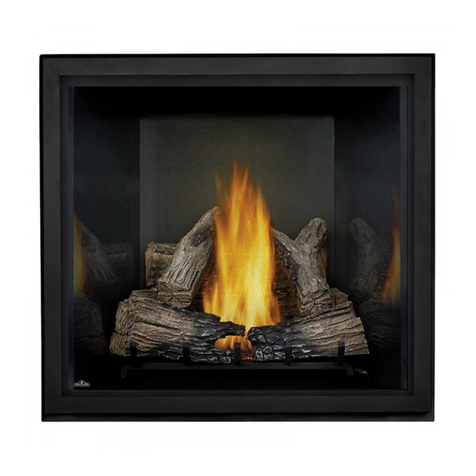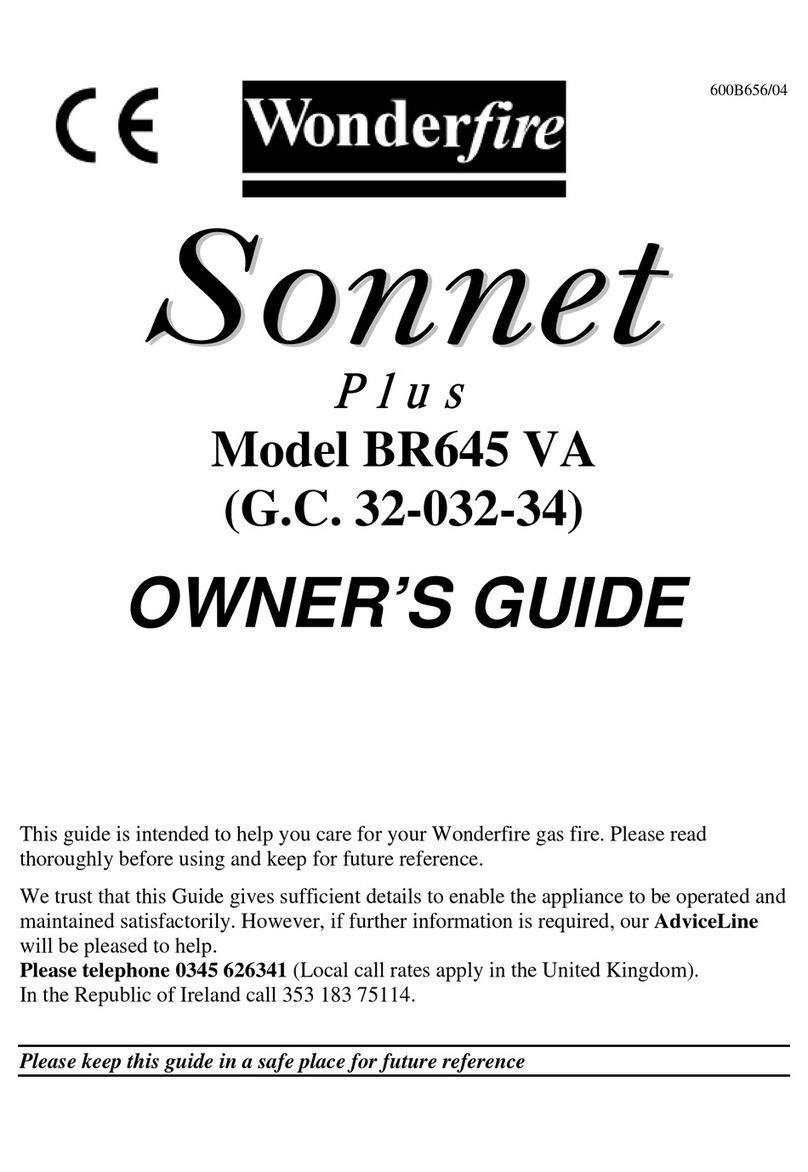
Heat & Glo • GEM-36B • 2095-900 Rev. H • 3/06 5
For all side wall horizontally vented gas fueled equipment
installed in every dwelling, building or structure used in
whole or in part for residential purposes, including those
owned or operated by the Commonwealth and where the
side wall exhaust vent termination is less than seven (7)
feetabovefinished gradeinthe area oftheventing, includ-
ing but not limited to decks and porches, the following re-
quirements shall be satisfied:
Installation of Carbon Monoxide Detectors
Atthetimeof installation of thesidewallhorizontal vented
gas fueled equipment, the installing plumber or gasfitter
shallobservethatahard wired carbon monoxidedetector
with an alarm and battery back-up is installed on the floor
level where the gas equipment is to be installed. In addi-
tion,theinstallingplumber or gasfitter shallobservethata
battery operated or hard wired carbon monoxide detector
with an alarm is installed on each additional level of the
dwelling,buildingorstructure served bythesidewall hori-
zontalventedgas fueledequipment.It shallbethe respon-
sibilityofthe propertyownerto securetheservices ofqual-
ifiedlicensedprofessionalsforthe installationofhard wired
carbonmonoxidedetectors.
In the event that the side wall horizontally vented gas fu-
eledequipmentisinstalled in acrawlspace or anattic,the
hard wired carbon monoxide detector with alarm and bat-
tery back-up may be installed on the next adjacent floor
level.
In the event that the requirements of this subdivision can
not be met at the time of completion of installation, the
ownershallhave a periodofthirty (30)daysto comply with
theaboverequirements;provided,however,thatduringsaid
thirty(30)day period, abatteryoperated carbonmonoxide
detector with an alarm shall be installed.
Approved Carbon Monoxide Detectors
Eachcarbonmonoxide detectorasrequired inaccordance
withtheabove provisions shallcomplywithNFPA720 and
beANSI/UL2034 listed and IAS certified.
Signage
Ametalorplasticidentification plate shall bepermanently
mountedtothe exteriorofthe buildingata minimumheight
of eight (8) feet above grade directly in line with the ex-
haust vent terminal for the horizontally vented gas fueled
heating appliance or equipment. The sign shall read, in
print size no less than one-half (1/2) inch in size, “GAS
VENT DIRECTLY BELOW. KEEP CLEAR OF ALL OB-
STRUCTIONS”.
Inspection
Thestateorlocal gasinspectorofthe sidewallhorizontally
ventedgasfueled equipmentshallnotapprove theinstalla-
tion unless, upon inspection, the inspector observes car-
bonmonoxidedetectorsandsignageinstalledin accordance
withtheprovisions of 248CMR5.08(2)(a)1 through 4.
Exemptions
Thefollowingequipmentisexemptfrom248CMR5.08(2)(a)1
through4:
• Theequipmentlistedin Chapter 10entitled“Equipment
Not Required To Be Vented” in the most current edition
of NFPA54 as adopted by the Board; and
• ProductApproved side wall horizontally vented gas fu-
eledequipmentinstalled in aroomor structureseparate
fromthedwelling,buildingor structure used inwholeor
inpartforresidential purposes.
MANUFACTURERREQUIREMENTS
Gas Equipment Venting System Provided
Whenthemanufacturer ofProductApprovedsidewall hori-
zontally vented gas equipment provides a venting system
designorventingsystem components with theequipment,
the instructions provided by the manufacturer for installa-
tionoftheequipment and theventingsystemshall include:
• Detailed instructions for the installation of the venting
system design or the venting system components; and
• A complete parts list for the venting system design or
ventingsystem.
Gas Equipment Venting System NOT Provided
When the manufacturer of a Product Approved side wall
horizontallyventedgasfueled equipment doesnotprovide
the parts for venting the flue gases, but identifies “special
venting systems”, the following requirements shall be sat-
isfiedbythemanufacturer:
• Thereferenced“specialventingsystem”instructionsshall
beincludedwiththe appliance orequipmentinstallation
instructions; and
• The“specialventingsystems”shallbeProductApproved
by the Board, and the instructions for that system shall
includeapartslist and detailed installationinstructions.
AcopyofallinstallationinstructionsforallProductApproved
sidewallhorizontally ventedgasfueledequipment,all vent-
ing instructions, all parts lists for venting instructions, and/
or all venting design instructions shall remain with the ap-
pliance or equipment at the completion of the installation.
See Gas Connection section for additional Common-
wealth of Massachusetts requirements.
NOTE: The following requirements reference various
Massachusetts and national codes not contained in
this document.
G. Requirements for the Commonwealth of
Massachusetts
Î






























